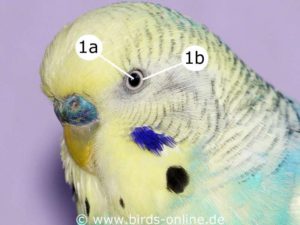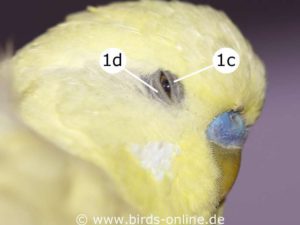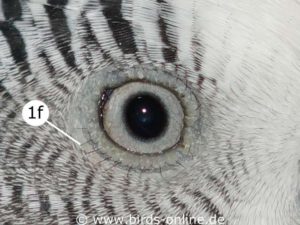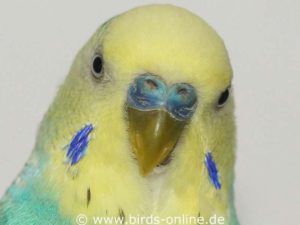Eyes
The eyes of the birds and those of humans show similarities on the one hand and some differences on the other hand. It is particularly noticeable that the eyes of birds are very large compared to the size of their skull. However, this is not obvious, because one sees only a small part of the bird’s eyes if you watch the animals. So the major part of the bird’s eye is invisible to the observer. Only in very young bird chicks whose feathers haven’t grown yet, one can get a slight idea of how huge the eyeballs truely are.
Visible parts of the bird’s eye

If you look at a budgie’s eye, you will see the pupil (1a) and the ring-shaped iris (1b). Depending on the color variety of the individual, the pupils are black, dark brown, red, or violet. The iris can be white, grey-brown, reddish, or black. In case it is black, it appears that the bird has no iris rings at all since they’re difficult to distinguish from the dark pupils. Not yet sexually mature budgies usually have a black iris. In some color varieties, the iris of adult budgies is dark as well.
Please note that the coloration of the iris is different in many other bird species. For example, some Amazons have an orange iris, in Diamond Doves it is red.

A healthy eye of a human has two eyelids with which it can be closed by movements of the lids from top to bottom and the other way round. Birds also have these two eyelids, they are called upper eyelid (1c) and lower eyelid (1d). Unlike our eyelids, however, the lids of the birds do not noticeably differ in size. That means the bird’s lower eyelid is nearly as large as the upper eyelid. They also can be closed by vertical movements. The skin is even thinner and more sensitive than our eyelids are. In some cases, you can even see the pupil of a budgie when the eyes are closed. The edge of each eyelid is a bit thicker than the rest. If you look at the bird’s eyes from the side, you will spot a small bulge on the edge of the eyelid.

Besides these two movable outer eyelids, the bird’s eye is equipped with a third, inner eyelid. This part of the bird’s eye is called the nictitating membrane (1e). It can be opened and closed laterally. It runs slightly diagonally, and in the resting position, it lies in the front area of the eye hidden underneath the upper eyelid. Experts assume that the nictitating membrane plays a decisive role in the dispersion of tear fluid.
In most bird species, including budgies, the nictitating membrane is transparent with a slight grayish tinge and is therefore rarely seen. However, there are also bird species in which the nictitating membrane is not transparent, but whitish and dull. One reason for this could be that it might serve these animals as an additional light shield.
At the edges of the upper and lower eyelid of the budgies, there are some very thin feathers (1f). Their shape is comparable with human eyelashes. But it’s not easy to see those tiny feather-like objects, you have to have a very close look. Usually, they are more prominent on the edge of the lower eyelid than on the upper ones. Their task is to protect the eye from dirt.
Structures inside the bird’s eye

The eye of a bird is made up of several parts and, in simple terms, is spherical. The largest portion of the bird’s eyeball is inside the skull. What is visible from the outside represents only a small part of the eye. If you look at a bird from the front, you can see a curvature of the eye. This is the transparent and smooth cornea.
Behind the cornea is the anterior chamber of the eye, which is filled with a watery fluid. It’s called aqueous humor. If the eyeball is injured, this fluid can leak. Behind the anterior chamber are the iris and the pupil. They are followed by another small chamber, the so-called posterior chamber of the eye, which is filled with a liquid. Behind this chamber is the lens followed by the vitreous body.
